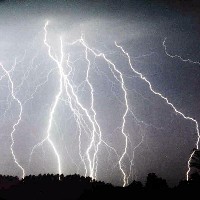 Engineers at Earth Networks in Germantown, Maryland developed a system for analyzing lightning occurrences during severe weather they say can increase lead times in predicting most tornados by 50 percent. Chonglin (Charlie) Liu of Earth Networks will discuss the company’s dangerous thunderstorm alert system in a presentation this week at a meeting of the American Meteorological Society in Austin, Texas.
Engineers at Earth Networks in Germantown, Maryland developed a system for analyzing lightning occurrences during severe weather they say can increase lead times in predicting most tornados by 50 percent. Chonglin (Charlie) Liu of Earth Networks will discuss the company’s dangerous thunderstorm alert system in a presentation this week at a meeting of the American Meteorological Society in Austin, Texas.
Earth Networks’ dangerous thunderstorm alert system detects both cloud-to-ground lightning and lightning contained within clouds — the majority of lightning occurrences in the atmosphere — called total lightning by meteorologists, from a network of more than 600 sensors worldwide. High rates of total lightning are considered early indicators of the potential for severe weather, such as damaging thunderstorms and tornados.
When the total lightning detection rate exceeds high levels, Earth Networks issues dangerous thunderstorm alert to its subscribers. The alert is updated every 15 minutes until the dangerous weather is no longer a threat and the alert expires.
Liu and colleagues reviewed all tornado reports in 2011 covered by both National Weather Service warnings for severe thunderstorm or tornados, and the company’s dangerous thunderstorm alerts. Their analysis indicates Earth Networks’ dangerous thunderstorm alerts improved the median lead times for tornados by nine minutes or 50 percent, when added to the 18-minute median lead time from National Weather Service warnings. The company notes that National Weather Service investments improved the agency’s tornado warning lead times from 4 minutes in 1987 to more than 14 minutes today.
“Minutes truly matter when it comes to severe weather and this technology will help save lives,” says Earth Networks president Bob Marshall. “The opportunity for this automated technology to cost effectively provide early storm warnings to people around the globe is unprecedented, as there are literally billions of people who have never received a severe weather warning.”
Since August 2012, Earth Networks furnishes data from its total lightning nework to National Weather Service for operational and research uses. The company says the number of lightning sensors in the network is expected to grow to more than 1,000 in the next 12 to 24 months.
Read more:
- Study: Insurance Industry Adjusting to Climate Change
- Prototype Net-Zero Energy Home Being Tested
- Methods Developed to Detect, Remove Ice from Aircraft Wings
- Grant to Fund New Program Logic for Flight Data Integration
- Weather Company to Partner with European Climate Researchers
Photo: Les Chatfield/Flickr
* * *

 RSS - Posts
RSS - Posts
You must be logged in to post a comment.